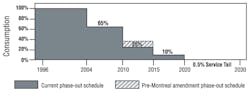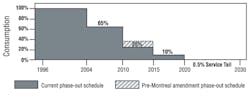Preparing for the HCFC Phase-Out
The Montreal Protocol, an international treaty designed to protect the ozone layer, was amended last fall to accelerate the phase-out of hydrochlorofluorocarbons (HCFCs). The refrigerants used in chillers, commonly referred to as HCFC-123 and HCFC-22, were targeted because they contain chlorine and have ozone-depletion potential (ODP).
In the new schedule for developed countries, HCFC-22 will be phased out of new equipment starting in 2010 and won't be produced or exported as of 2020 (with a 0.5-percent service tail to 2030). HCFC-123 will be phased out in 2020 (with a 0.5-percent service tail), but won't be produced or exported as of 2030. The biggest recent change to this schedule is a 2015 review to determine if the service tails are necessary after 2020. If the timeline is shortened, all equipment using HCFC refrigerants will rely on reclaimed refrigerant as of 2020.
For those with recently manufactured equipment, this acceleration will be of little concern: Today's alternative hydrofluorocarbons (HFC) refrigerants—HFC-134a, HFC-410A, and HFC-407C—lack chlorine atoms, have ODPs of zero, and are not targeted by the Montreal Protocol. More than 80 percent of centrifugal chillers currently manufactured employ HFC-134a, and most manufacturers have stopped producing HCFC-dependent equipment.
But, for those with chillers utilizing older HCFCs, it's time to make plans to meet the new guidelines. Retrofitting older machines to accept HFCs probably isn't realistic. HCFC-22 machines cannot accept HFC-410A because the required operating pressure differences are simply too great. HCFC-22 equipment could be retrofitted to accept HFC-407C, but only with losses of cooling capacity and efficiency, and with increased maintenance costs. And, although retrofitting HCFC-123 chillers to accept HFC refrigerants may technically be possible, doing so would be questionable in terms of practicality, safety, and economic feasibility due to opposing pressures and volumetric efficiencies.
The question then becomes one of replacement—and whether to wait until phase-out dates hit or to replace machinery ahead of schedule.
"Anyone making an equipment revision must consider the availability of refrigerants over the equipment's life," says Roy Hubbard, senior marketing manager for Milwaukee, WI-based Johnson Controls Inc. "With equipment life around 30 years, someone with HCFC machinery could be in jeopardy when refrigerant availability becomes increasingly curtailed. Consider cost, too. Newer machines are more efficient and cost less to maintain. You'll get more return on your investment."
Daryl Showalter, director of marketing for Minneapolis-based McQuay Intl., agrees, saying, "If I had a 10-year-old centrifugal using HCFC refrigerant, I'd consider replacing it now—you'll avoid future high prices on reclaimed refrigerants as supply dwindles, and full-load energy efficiencies have increased in the past 10 years by 10 to 15 percent while part-load efficiencies have increased by 25 to 30 percent. Payback averages 3 years or less."
"There are good reasons to eliminate reliance on these refrigerants ahead of schedule," says Mike Opitz, director of LEED implementation for the Washington, D.C.-based U.S. Green Building Council. "A new, efficient, low-maintenance system saves energy and money, and may save labor and repair costs. Building owners who wait until they have to upgrade are barely complying with federal regulations; those who do it early for sound business reasons are considered high performance."
Stephanie J. Oppenheimer, former assistant vice president of communications at BOMA Intl., is principal at Skylite Communications, based in Falls Church, VA.

